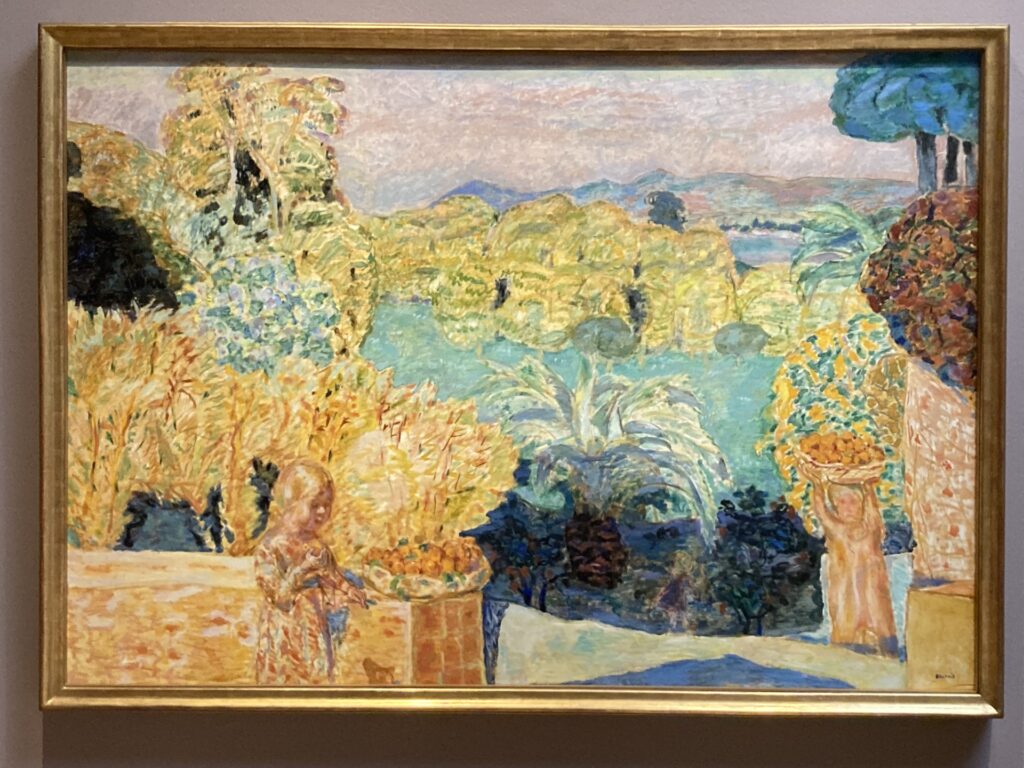‘Bonnard’s Worlds’ at the Phillips
By • May 23, 2024 0 701

One of the most captivating art museum experiences in Washington, D.C., a city with many, is the Phillips Collection’s Rothko Room. In this small gallery, seated on a bench in low light, the visitor communes with the painter’s layered, soft-edged rectangles of color on all sides.
At the Phillips through June 2, a second such encounter is available one floor above. To the right of the entrance to “Bonnard’s Worlds,” six paintings by the French artist — a major influence on Mark Rothko’s mature style — seem to dissolve the walls of a large rectangular gallery, soaking up light from a ceiling opening.
Born in 1867, Pierre Bonnard was two years older than Matisse. Both had an independent streak, though Matisse was the bolder artist, and both were consumed with pattern, color and the window as a compositional element. However, starting in the early 1900s, landscape became an obsession for Bonnard.
In 1940, while living in Le Bosquet (The Grove), his house in Le Cannet, near Cannes, Bonnard wrote to Matisse: “My work is going pretty well, especially in the direction of understanding. During my morning walks I amuse myself by defining different conceptions of landscape — landscape as ‘space,’ intimate landscape, decorative landscape, etc. But as for vision, I see things differently every day, the sky, objects, everything changes continually, you can drown in it.”
Joining the Phillips Collection’s “The Terrace” of 1918 — painted in Vernonnet, across the Seine from Monet’s lush garden in Giverny — in the skylighted gallery are: “Southern Landscape With Two Children” of 1916-18, from the Art Gallery of Ontario, in which the children resemble gilded garden statues; “Earthly Paradise” of 1916-20, from the Art Institute of Chicago, with a nondescript Adam in shadow and a languorously nude Eve; and “Landscape at Le Cannet” of 1928, from the show’s co-organizer, Fort Worth’s Kimbell Art Museum, with horizontal bands of hills receding to the top of the canvas.
Also in that gallery — completed in 1946, shortly before Bonnard’s death, early in 1947 — “Studio With Mimosa, Le Cannet,” from the Centre Pompidou, is nearly all window, through which a mimosa’s blooms form a large, irregular patch of bright yellow. (Bonnard’s conservative nature goes out the window, so to speak, with his use of cadmium yellow, in the footsteps of Gauguin and van Gogh.) Tucked in the lower left corner is a tiny brown head — the artist’s?
Duncan and Marjorie Phillips met Bonnard when he came to the U.S. as a juror for the 1926 Carnegie International in Pittsburgh. They acquired two landscapes from a New York gallery show in 1928, his first solo exhibition outside France: “The Riviera” of c. 1923 and “The Palm” of 1926.
In assembling their collection, which went on public view in an upstairs room of the family’s Dupont Circle mansion in 1921, they sought to bring together a representative cluster of key works by important artists, which Duncan Phillips called a “unit.”
Visiting “Bonnard’s Worlds,” co-curated by Phillips Chief Curator Elsa Smithgall and Kimbell Deputy Director George T.M. Shackelford, it is as if the Phillips Collection’s “Bonnard unit” multiplied like the painter’s mimosa, taking over the entire third floor. The “worlds” of the title refers to the grouping of paintings by “sensory spheres of experience” and “measures of intimacy.” With some intermingling, one transitions from landscapes to gardens to interiors to still lifes.
Bonnard is often paired with Édouard Vuillard, one year younger, as the most noteworthy of Les Nabis (The Prophets), a group of young painters who studied at the Académie Julian and whose Post-Impressionist path was blazed by Gauguin. The two have also been called “Intimists” for their closely observed, pattern-rich depiction of domestic subjects.
Bonnard was considered the most “Japanese” of the Nabis for his complex, flattened compositions, inspired by Japanese woodblock prints. Two charming examples in the exhibition: “Women With a Dog” of 1891, from the Clark Art Institute; and “Twilight (The Game of Croquet)” of 1892, from the Musée d’Orsay (with a different dog).
Vuillard’s world was left far behind not only by Bonnard’s sun-drenched landscapes but by his female nudes, often shown bathing, à la Degas. In one section of the exhibition are six paintings of Maria Boursin, known as Marthe, Bonnard’s model, lover and eventual wife, about to get in the tub, submerged or just having gotten out. The equals of those by Degas and Modigliani, these works are also Matisse-like assemblages of pattern, with a mastery of reflected and refracted light that is Bonnard’s own.
Another Bonnard signature: Two of the “Marthe bathing” paintings include a “red” smooth-coat dachshund; over time, he owned six, all named Poucette (Thumbalina, sort of).
More dogs, and black and white cats, inhabit Bonnard’s interiors and still lifes, on view in two adjacent galleries. Examining these odd-angled, at times playful, paintings, one grasps what Bonnard meant when he said: “Art is all in the composition; it is the key to everything.”
Though the landscapes of the skylighted gallery are truly a different world, the lessons of Bonnard’s early years as poster designer and magazine and book illustrator were not forgotten. Hinting at this, two books of Paul Verlaine’s poetry, from 1900 and 1902, with lithographs by Bonnard, are on view.
Appended to the exhibition is a study and program room called the Bonnard Salon, with sofas, a mirror (another favorite Bonnard element), archival materials and two paintings. Upcoming programs: a Dupont nature walk with Carrie Vaughn, farm director of THEARC, on May 24; a wildflower arranging workshop led by Karen Massalley of Massalley Design on May 31; and a conversation with artists Jennifer Packer and Taha Heydari, moderated by Smithgall, on closing day, June 2.
“Bonnard’s Worlds”
Through June 2
1600 21st St. NW
202-387-2151

